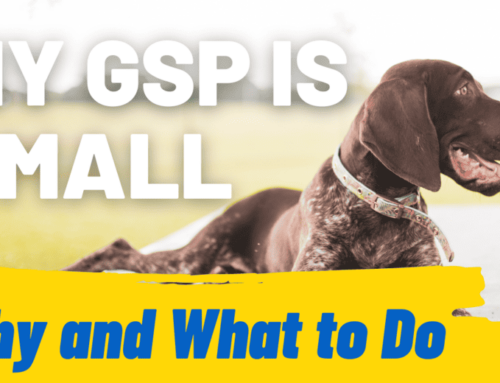How high your dog can jump is a consideration when fencing your yard, leaving your pet in any type of enclosure, or even when choosing a dog for a fun sport, like agility!
As a bigger dog, Golden Retrievers can certainly jump higher than some other dogs. We’ll take a look at what it takes to contain a Golden Retriever, as well as how to safely engage them in jumping activities.

Fences and Golden Retrievers
The average Golden Retriever will not be able to jump over 4-feet high. This doesn’t mean that a 4-foot fence is escape-proof. If your dog is prone to escaping, you’ll likely want a fence that is higher. The type of fence is also a consideration, as a smooth surface will be more difficult to vault.
Keeping the fence as vertical and smooth as possible, and keeping objects that can be used as steps away from the fence, will help make a shorter fence a safer possibility.
Chain link fencing is relatively easy for dogs to climb, as is a wooden fence with slats that run parallel to the ground.
Vinyl is often a much smoother option, or a wooden fence that is smooth on both sides.
Regardless of the height of your fence, dogs should always be supervised when outside.
Fences may not prevent other animals from entering your yard, whether they are wild animals that may cause harm to your dog, or another dog that may be wandering.
Fences also pose a safety hazard if your dog does try to jump and is unsuccessful.
Dogs have been known to catch their collars in the fence and hang themselves, as well as catch legs or other body parts in the slats of fences.
Some fences can even cause wounds as your dog attempts to clear the top.
By monitoring your dog, you can ensure they are safe and intervene if something were to happen.
If you do have a dog that jumps the fence, it can be frustrating to follow local fencing laws in certain areas.
In towns that limit the height of a fence to 3 or 4 feet, your Golden Retriever may still be able to grab the top of the fence to pull themselves over the top, even if the fence is smooth.
In this case, you can consider keeping your dog leashed or on a long line in the yard.
You can also consider adding a piece to the top of your fences known as a coyote roller.
You can purchase a kit or make it yourself, but a coyote roller generally consists of a pipe, such as PVC, that is strung along heavy rope and suspended just above the top of the fence line.
When your Golden Retriever jumps to try and grab the top of the fence, the PVC pipe will spin and drop your dog back into the yard.
Originally designed to help keep chickens and other livestock safe from coyotes, they also work well to help keep your dog in the yard.
Are you interested in reading this: Will My Dog Jump Out of the Car Window?

How High Can I Make My Golden Retriever Jump?
You may also be wondering how high is safe to ask your Golden Retriever to jump, such as over an obstacle course or in or out of a vehicle. It’s best to always check with your vet, but there are several general guidelines that can help you keep your Golden Retriever safe when jumping for fun.
First, you’ll want to avoid jumping until your Golden Retriever is at least 12-18 months old.
Younger than that, and your Golden Retriever will have open growth plates that can be damaged.
These growth plates are soft areas of the long bones, from which the leg bones extend and grow.
Until a dog is done growing, around 12-18 months for most Golden Retrievers, these growth plates are considered open and can be damaged if too much jumping or heavy exercise occurs.
After your Golden Retriever is older and their growth plates have closed, you will still want to ease your dog into any jumping.
To start, ask them to jump over objects that are the same height as their pasterns – their ankles – or lower.
In general, keeping jumps at the height of your dog’s elbows or lower is safest when practicing jumps.
If you do decide to compete in a sport such as agility, where jumping is a main activity, you may need to teach your Golden Retriever to jump a bar that is around the same height as their shoulders – their withers – or slightly higher.
However, when you’re doing multiple repetitions, not all jumps have to be this maximum height.
In fact, since much of agility involves the handling and how you direct your dog around the course, you can practice a lot with bars that are elbow height or lower.
It’s not necessary or recommended to make your dog jump higher than what they need to jump in a sport.
You should keep this all in mind even if you are not practicing for an agility trial.
Your Golden Retriever will come across things they may want to jump or that you may ask them to jump in many areas of their life.
Hiking in the woods may be full of fallen trees or rocks that are prime opportunities for jumping, and even just jumping on and off of furniture in your home should be considered.

Risks Associated With Jumping
As previously mentioned, you shouldn’t be jumping your Golden Retriever until they are old enough to have closed growth plates. However, open growth plates are not the only potential threat to your Golden Retriever’s health when they are jumping.
Golden Retrievers, like many dogs, are prone to obesity. This is especially true when you consider the more sedentary lifestyle that many dogs lead, as well as how many owners show their love by feeding their dog excessive food or extra treats.
Jumping when overweight is extremely harmful to your dog’s joints. Plus, it’s not the only medical problem that can come from obesity.
For the sake of your Golden Retriever’s health, it’s critical that you keep them fit and slender – even more so than normal if you want to ask them to jump for tricks or sport.
It’s also a good idea to get your Golden Retriever from a breeder who does the necessary health testing, including OFA or PennHip x-rays of their hips and elbows to ensure their parents have healthy joints.
It’s not a guarantee that their puppies will have healthy joints, but it definitely stacks the deck in your puppy’s favor.
Also, keep in mind that your Golden Retriever may become sore and pull a muscle if not properly conditioned.
Because Golden Retrievers love to work with their owners, especially for a toy or treat, it’s easy to push them into doing something that is painful when they are trying to do what you ask.
Instead, take things slow, and check with your dog’s veterinarian before beginning any intense exercise regime.
If your Golden Retriever is not fit for jumping but needs to engage in activities that might normally require jumping, such as getting into a truck or going over a fallen tree, you have a few options.
Which option is best depends on if this is a long-term problem, or if you are simply being careful as your Golden Retriever loses weight.
Some slings are available to help lift a dog, and can be ideal for lifting them into a vehicle – especially if two people are able to help.
Otherwise, a harness such as the Ruffwear Webmaster that contains a handle and fits securely and safely around your Golden Retriever can allow you to assist them on hikes without needing to lift your dog entirely.
Besides checking with your Golden Retriever’s veterinarian about their health, you can also consider meeting with a veterinarian specializing in rehabilitation or sports to help you put together a plan that is best for your dog.




